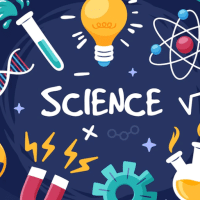Class 9 Exam > Class 9 Questions > Can you explain the answer of this question b...
Start Learning for Free
Can you explain the answer of this question below:
Which is the smallest particle of an element that can take part in a chemical reaction?
- A:Molecule
- B:Mixture
- C:Compound
- D:Atom
The answer is d.
Most Upvoted Answer
Can you explain the answer of this question below:Which is the smalles...
The basic unit of matter is the atom. It is the smallest particle of an element which can take part in chemical reactions and may or may not exist separately. It consists of sub-atomic particles, i.e., protons, neutrons and electrons.
Free Test
FREE
| Start Free Test |
Community Answer
Can you explain the answer of this question below:Which is the smalles...
The correct answer is option 'D', atom.
Explanation:
An atom is the smallest particle of an element that can take part in a chemical reaction. To understand why this is the case, let's break down the other options and understand their meanings:
a) Molecule: A molecule is formed when two or more atoms combine chemically. However, not all elements exist as molecules. Elements like hydrogen and oxygen exist as diatomic molecules (H2 and O2), while others like helium exist as single atoms (He). Therefore, a molecule is not always the smallest particle of an element that can take part in a chemical reaction.
b) Mixture: A mixture is a combination of two or more substances that are physically mixed together. In a mixture, the substances retain their individual properties and can be separated by physical means. While elements can certainly be part of a mixture, a mixture itself does not represent the smallest particle of an element that can take part in a chemical reaction.
c) Compound: A compound is a substance formed when two or more elements chemically combine in a fixed ratio. Compounds consist of molecules or ions that are made up of multiple atoms bonded together. While compounds are formed from elements, they are not the smallest particle of an element. Instead, compounds are the result of the combination of different elements.
d) Atom: An atom is the smallest unit of an element that retains the chemical properties of that element. Atoms consist of a nucleus, which contains protons and neutrons, surrounded by electrons. Atoms can combine with other atoms through chemical reactions to form molecules or compounds. When a chemical reaction occurs, it is the atoms that are rearranged or combined to form new substances.
In summary, the smallest particle of an element that can take part in a chemical reaction is an atom. Atoms combine to form molecules or compounds, but they themselves are the fundamental building blocks of matter.
Explanation:
An atom is the smallest particle of an element that can take part in a chemical reaction. To understand why this is the case, let's break down the other options and understand their meanings:
a) Molecule: A molecule is formed when two or more atoms combine chemically. However, not all elements exist as molecules. Elements like hydrogen and oxygen exist as diatomic molecules (H2 and O2), while others like helium exist as single atoms (He). Therefore, a molecule is not always the smallest particle of an element that can take part in a chemical reaction.
b) Mixture: A mixture is a combination of two or more substances that are physically mixed together. In a mixture, the substances retain their individual properties and can be separated by physical means. While elements can certainly be part of a mixture, a mixture itself does not represent the smallest particle of an element that can take part in a chemical reaction.
c) Compound: A compound is a substance formed when two or more elements chemically combine in a fixed ratio. Compounds consist of molecules or ions that are made up of multiple atoms bonded together. While compounds are formed from elements, they are not the smallest particle of an element. Instead, compounds are the result of the combination of different elements.
d) Atom: An atom is the smallest unit of an element that retains the chemical properties of that element. Atoms consist of a nucleus, which contains protons and neutrons, surrounded by electrons. Atoms can combine with other atoms through chemical reactions to form molecules or compounds. When a chemical reaction occurs, it is the atoms that are rearranged or combined to form new substances.
In summary, the smallest particle of an element that can take part in a chemical reaction is an atom. Atoms combine to form molecules or compounds, but they themselves are the fundamental building blocks of matter.

|
Explore Courses for Class 9 exam
|

|
Question Description
Can you explain the answer of this question below:Which is the smallest particle of an element that can take part in a chemical reaction?A:MoleculeB:MixtureC:CompoundD:AtomThe answer is d. for Class 9 2025 is part of Class 9 preparation. The Question and answers have been prepared according to the Class 9 exam syllabus. Information about Can you explain the answer of this question below:Which is the smallest particle of an element that can take part in a chemical reaction?A:MoleculeB:MixtureC:CompoundD:AtomThe answer is d. covers all topics & solutions for Class 9 2025 Exam. Find important definitions, questions, meanings, examples, exercises and tests below for Can you explain the answer of this question below:Which is the smallest particle of an element that can take part in a chemical reaction?A:MoleculeB:MixtureC:CompoundD:AtomThe answer is d..
Can you explain the answer of this question below:Which is the smallest particle of an element that can take part in a chemical reaction?A:MoleculeB:MixtureC:CompoundD:AtomThe answer is d. for Class 9 2025 is part of Class 9 preparation. The Question and answers have been prepared according to the Class 9 exam syllabus. Information about Can you explain the answer of this question below:Which is the smallest particle of an element that can take part in a chemical reaction?A:MoleculeB:MixtureC:CompoundD:AtomThe answer is d. covers all topics & solutions for Class 9 2025 Exam. Find important definitions, questions, meanings, examples, exercises and tests below for Can you explain the answer of this question below:Which is the smallest particle of an element that can take part in a chemical reaction?A:MoleculeB:MixtureC:CompoundD:AtomThe answer is d..
Solutions for Can you explain the answer of this question below:Which is the smallest particle of an element that can take part in a chemical reaction?A:MoleculeB:MixtureC:CompoundD:AtomThe answer is d. in English & in Hindi are available as part of our courses for Class 9.
Download more important topics, notes, lectures and mock test series for Class 9 Exam by signing up for free.
Here you can find the meaning of Can you explain the answer of this question below:Which is the smallest particle of an element that can take part in a chemical reaction?A:MoleculeB:MixtureC:CompoundD:AtomThe answer is d. defined & explained in the simplest way possible. Besides giving the explanation of
Can you explain the answer of this question below:Which is the smallest particle of an element that can take part in a chemical reaction?A:MoleculeB:MixtureC:CompoundD:AtomThe answer is d., a detailed solution for Can you explain the answer of this question below:Which is the smallest particle of an element that can take part in a chemical reaction?A:MoleculeB:MixtureC:CompoundD:AtomThe answer is d. has been provided alongside types of Can you explain the answer of this question below:Which is the smallest particle of an element that can take part in a chemical reaction?A:MoleculeB:MixtureC:CompoundD:AtomThe answer is d. theory, EduRev gives you an
ample number of questions to practice Can you explain the answer of this question below:Which is the smallest particle of an element that can take part in a chemical reaction?A:MoleculeB:MixtureC:CompoundD:AtomThe answer is d. tests, examples and also practice Class 9 tests.

|
Explore Courses for Class 9 exam
|

|
Signup for Free!
Signup to see your scores go up within 7 days! Learn & Practice with 1000+ FREE Notes, Videos & Tests.
























